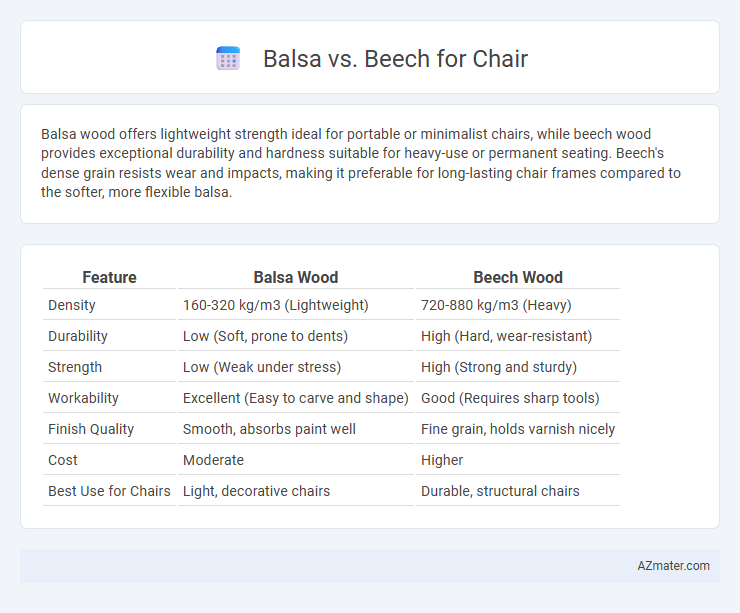Balsa wood offers lightweight strength ideal for portable or minimalist chairs, while beech wood provides exceptional durability and hardness suitable for heavy-use or permanent seating. Beech's dense grain resists wear and impacts, making it preferable for long-lasting chair frames compared to the softer, more flexible balsa.
Table of Comparison
| Feature | Balsa Wood | Beech Wood |
|---|---|---|
| Density | 160-320 kg/m3 (Lightweight) | 720-880 kg/m3 (Heavy) |
| Durability | Low (Soft, prone to dents) | High (Hard, wear-resistant) |
| Strength | Low (Weak under stress) | High (Strong and sturdy) |
| Workability | Excellent (Easy to carve and shape) | Good (Requires sharp tools) |
| Finish Quality | Smooth, absorbs paint well | Fine grain, holds varnish nicely |
| Cost | Moderate | Higher |
| Best Use for Chairs | Light, decorative chairs | Durable, structural chairs |
Overview: Balsa vs Beech Wood
Balsa wood is renowned for its remarkably light weight and softness, making it ideal for lightweight chair designs that prioritize comfort and ease of movement. Beech wood, on the other hand, offers exceptional hardness and durability with a fine grain, providing sturdy support and a smooth finish suited for long-lasting, high-quality chairs. Choosing between balsa and beech depends on the balance between weight preference and the desired strength of the chair.
Botanical Origins and Growth Patterns
Balsa (Ochroma pyramidale) is a fast-growing tropical hardwood native to Central and South America, characterized by its lightweight cellular structure that allows rapid trunk expansion and quick maturity within 6 to 10 years. Beech (Fagus sylvatica), predominantly found in temperate Europe, develops slowly with dense, tight grain due to its deciduous nature and gradual growth over 40 to 80 years, resulting in a durable and fine-textured wood ideal for furniture like chairs. The contrasting growth patterns--balsa's rapid, porous growth versus beech's slow, dense formation--significantly influence their strength, weight, and suitability for ergonomic chair design.
Density and Weight Comparison
Balsa wood has an exceptionally low density of about 160 kg/m3, making it one of the lightest woods ideal for lightweight chair designs. In contrast, Beech wood features a much higher density, approximately 720 kg/m3, providing greater durability and sturdiness for chair construction. The significant difference in density directly affects the weight, with Balsa chairs being considerably lighter but less robust compared to heavier, more resilient Beech chairs.
Strength and Durability Factors
Beech wood offers superior strength and durability compared to balsa, making it the preferred choice for chair construction where long-term support is essential. Balsa is significantly lighter and softer, resulting in less resistance to wear and potential damage under heavy use. The dense, hardwood fibers of beech provide excellent load-bearing capacity and resistance to deformation, ensuring chair longevity.
Workability and Machining Ease
Balsa wood is extremely lightweight and soft, making it highly workable and easy to machine with hand or power tools, ideal for intricate chair components requiring fine details. Beech wood, denser and harder, offers excellent machining precision and durability but demands sharper tools and slower feed rates to prevent burning or tear-out. The choice hinges on balancing balsa's effortless shaping with beech's structural strength and smooth finish for chair construction.
Comfort and Ergonomics in Chair Design
Balsa wood offers exceptional lightweight properties, enhancing ease of movement and overall comfort in chair design, while its natural flexibility provides ergonomic support by conforming to body contours. Beech wood, known for its durability and firmness, delivers robust structural support that promotes proper posture and long-term comfort in seating. Chairs crafted from beech typically feature greater resistance to wear, ensuring ergonomic stability and sustained comfort over extended use.
Finishing and Appearance Differences
Balsa wood features a lightweight, pale appearance with a smooth tactile finish, often requiring sealants or clear coats to enhance durability and maintain its natural look. Beech wood presents a fine, tight grain with a warm, reddish-brown hue that accepts stains and varnishes well, resulting in a polished, professional aesthetic. The finishing process on beech highlights its natural grain patterns, while balsa's softness demands gentle treatment to prevent dents and maintain visual appeal.
Cost and Availability in Furniture Making
Balsa wood is significantly cheaper and more readily available in bulk due to its fast growth and lightweight nature, making it a cost-effective choice for low-cost furniture and prototype chairs. Beech wood, while more expensive, is widely available in hardwood supply and preferred for durable, high-quality chair manufacturing thanks to its strength and fine grain. The choice between balsa and beech largely depends on budget constraints and the desired durability and finish of the chair.
Eco-Friendliness and Sustainability
Balsa wood is highly eco-friendly due to its rapid growth rate, providing a renewable resource with a low environmental impact, ideal for sustainable chair production. Beech wood, while slower growing, is sourced from responsibly managed forests and offers durability, making it a sustainable choice when certified by organizations like FSC. Choosing balsa or beech for chairs balances environmental benefits with performance, supporting sustainable forestry and reducing carbon footprints.
Best Applications: Which Wood Wins for Chairs?
Beech wood is ideal for chairs requiring durability and strength, offering excellent resistance to wear and a smooth finish suitable for detailed craftsmanship. Balsa, known for its exceptional lightness and softness, excels in applications where weight reduction is critical but lacks the structural integrity needed for everyday chair use. For most chair designs demanding long-term stability and resilience, beech wood is the superior choice, while balsa serves better in prototype or decorative elements where minimal weight is prioritized.

Infographic: Balsa vs Beech for Chair
 azmater.com
azmater.com